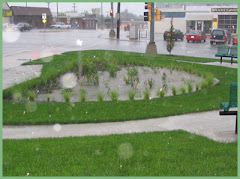
Skematic Bold Line Designs by Derek Anderson
Site Plan & Cross Section by Travis Helm
I decided to create a site plan and cross sectional drawing to illustrate how the building and its lot can harvest rainwater in partnership.
Here is the process of a rainwater recycling system:
- Roof catcment area receives rainfall, and then flows into gutters
- Gutters are sloped toward a downspout, where it is transfered down to the perimeter drain
- This perimeter drain will convey the water usually to the street sewer, but with a retention/harvesting system the water is directed to an underground storage tank, where it is filtered from debris and ready for re-use.
- The storage tank incorporates a submersible pump, where it will pump the rainwater into the house for pressurized non-potable uses such as toilets, dishwashers, washing machines, or irrigation.
The rain barrel used on the east side is similar, but uses gravity feed as its pressurization. Overflow from the storage tank and rain barrel can be easily be piped to an adjacent garden for irrigation. The water used for the gardens can infiltrate back into ground naturally.
Making use of rainwater is very important for communities facing either a water shortage or the problem of congested storm sewers looking for relief. With rainwater harvesting, both of these issues can be resolved.
About 40% of domestic water use in the summer is used for watering lawns, this water is chlorinated and treated so it is suitable enough for people to drink. This can easily be eliminated with use of rainwater to water lawns instead, because it does not need the extra sterilization.




6 comments:
The graphic looks really great Derek! A good all around outline of the exact process and steps in how rainwater can be directed.
I really like the layout of your blog :) Everything is clear and explained well. Here are some links that maybe helpful with your project:
http://www.amazon.ca/Design-Water-Rainwater-Harvesting-Stormwater/dp/0865715807
http://www.arch.mcgill.ca/prof/bourke/arch672/fall2002/precip.htm
Excellent work Derek!
Be sure to give yourself and Travis credit for the drawings. It is best if you state this directly under each one so there is no confusion.
For some reason the site plan does not get bigger when you click on it. Hopefully you can fix this.
I found another book at home about rainwater collection. I will bring it in so that you can have a look.
Well done buddy. I had that same sort of problem with one of my pics not getting bigger when you click on it. I'll give you a hand later, and we can figure that out.
As for the schematics, They look really good. Nice House.
Hi Derek
I love this idea, and think it should be a mandatory part of all buildings and subdivs. I have a video that shows a simple and effective way for homwowners to build their own rainwater retention system, its called "building with awareness". If you would like to see it just let me know.
What are you analyzing? How much water Kamloops could save if we switched to rainwater usage? Or how the water table would be affected?
Do you know if there are there any companies that provide this service to people? Maybe that would be a good niche market, especially in deserts.
Here is a site i found on some rainwater harvesting
http://www.harvesth2o.com/
Post a Comment